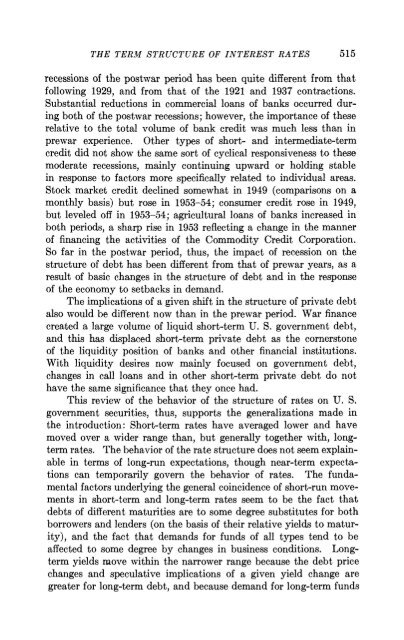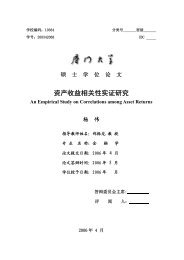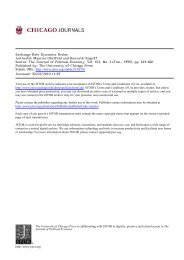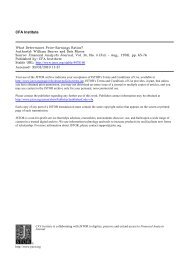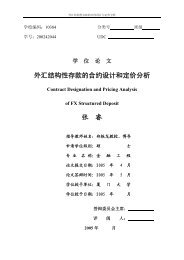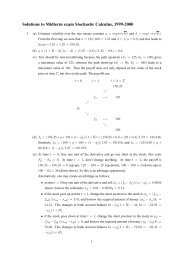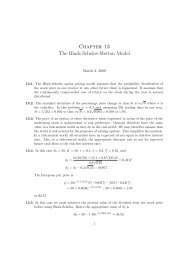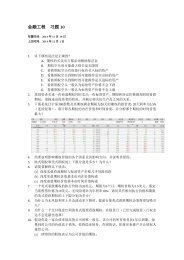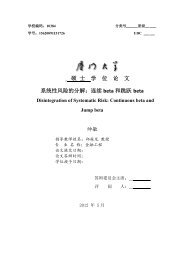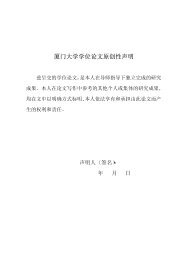The Term Structure of Interest Rates
The Term Structure of Interest Rates
The Term Structure of Interest Rates
You also want an ePaper? Increase the reach of your titles
YUMPU automatically turns print PDFs into web optimized ePapers that Google loves.
THE TERM STRUCTURE OF INTEREST RATES 515<br />
recessions <strong>of</strong> the postwar period has been quite different from that<br />
following 1929, and from that <strong>of</strong> the 1921 and 1937 contractions.<br />
Substantial reductions in commercial loans <strong>of</strong> banks occurred during<br />
both <strong>of</strong> the postwar recessions; however, the importance <strong>of</strong> these<br />
relative to the total volume <strong>of</strong> bank credit was much less than in<br />
prewar experience. Other types <strong>of</strong> short- and intermediate-term<br />
credit did not show the same sort <strong>of</strong> cyclical responsiveness to these<br />
moderate recessions, mainly continuing upward or holding stable<br />
in response to factors more specifically related to individual areas.<br />
Stock market credit declined somewhat in 1949 (comparisons on a<br />
monthly basis) but rose in 1953-54; consumer credit rose in 1949,<br />
but leveled <strong>of</strong>f in 1953-54; agricultural loans <strong>of</strong> banks increased in<br />
both periods, a sharp rise in 1953 reflecting a change in the manner<br />
<strong>of</strong> financing the activities <strong>of</strong> the Commodity Credit Corporation.<br />
So far in the postwar period, thus, the impact <strong>of</strong> recession on the<br />
structure <strong>of</strong> debt has been different from that <strong>of</strong> prewar years, as a<br />
result <strong>of</strong> basic changes in the structure <strong>of</strong> debt and in the response<br />
<strong>of</strong> the economy to setbacks in demand.<br />
<strong>The</strong> implications <strong>of</strong> a given shift in the structure <strong>of</strong> private debt<br />
also would be different now than in the prewar period. War finance<br />
created a large volume <strong>of</strong> liquid short-term U. S. government debt,<br />
and this has displaced short-term private debt as the cornerstone<br />
<strong>of</strong> the liquidity position <strong>of</strong> banks and other financial institutions.<br />
With liquidity desires now mainly focused on government debt,<br />
changes in call loans and in other short-term private debt do not<br />
have the same significance that they once had.<br />
This review <strong>of</strong> the behavior <strong>of</strong> the structure <strong>of</strong> rates on U. S.<br />
government securities, thus, supports the generalizations made in<br />
the introduction: Short-term rates have averaged lower and have<br />
moved over a wider range than, but generally together with, longterm<br />
rates. <strong>The</strong> behavior <strong>of</strong> the rate structure does not seem explainable<br />
in terms <strong>of</strong> long-run expectations, though near-term expectations<br />
can temporarily govern the behavior <strong>of</strong> rates. <strong>The</strong> fundamental<br />
factors underlying the general coincidence <strong>of</strong> short-run movements<br />
in short-term and long-term rates seem to be the fact that<br />
debts <strong>of</strong> different maturities are to some degree substitutes for both<br />
borrowers and lenders (on the basis <strong>of</strong> their relative yields to maturity),<br />
and the fact that demands for funds <strong>of</strong> all types tend to be<br />
affected to some degree by changes in business conditions. Longterm<br />
yields move within the narrower range because the debt price<br />
changes and speculative implications <strong>of</strong> a given yield change are<br />
greater for long-term debt, and because demand for long-term funds


